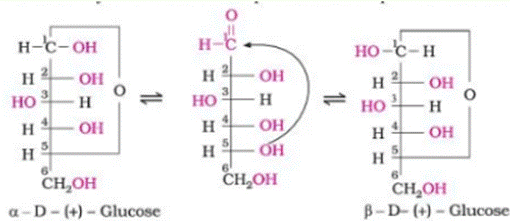- Home/
- CDS & Defence/
- Article
What are Anomers?
By BYJU'S Exam Prep
Updated on: September 25th, 2023
Anomers are cyclic monosaccharides which differ from one another in the configuration of C-1 or C-2 carbon.
A pair of anomers, which differ only at the carbon bearing the aldehyde or ketone functional group in the sugar’s open-chain form, are two nearly identical stereoisomers in the study of carbohydrates. Since the anomeric carbon is planar and achiral in open-chain form, anomers can only occur when the sugar is in its cyclic form. In a cyclic saccharide, an anomer is an epimer at the hemiacetal/hemiketal carbon, to put it more precisely. The process of changing one anomer into another is known as anomerization. Various anomers have different physical characteristics, melting points, and particular rotations, as is normal for stereoisomeric substances.
The process of changing one anomer into another is known as anomerization. Anomerization, also known as mutarotation, happens easily in solution and is catalysed by acid and base in the case of reducing sugars. This reversible process often results in an anomeric combination where the two separate anomers eventually approach equilibrium.
Table of content
Anomers
- Cyclic monosaccharides known as anomers differ from one another by the orientation of their C-1 or C-2 carbons.
- For aldoses, it is C-1 and C-2 for ketoses.
Example
The following are two examples of glucose’s cyclic hemiacetal form:

Example of anomers are α-D -Glucose, and β-D -glucose, because the position of a hydroxyl group at carbon 1(C1) is different.
Summary:-
What are Anomers?
Cyclic monosaccharides known as anomers differ from one another depending on whether they include C-1 or C-2 carbons.
Related Questions:-
- A Person With a Myopic Eye Cannot See Objects Beyond 12 M Distinctly What Should Be the Type of Corrective Lens
- A Point Object is Placed at a Distance of 30 Cm From a Convex Mirror of Focal Length of 30 Cm the Image Will Form at
- Derive the Third Equation of Motion V2 Minus U2 Equal to 2as
- Find the Sum 1 Plus 2 Plus 3 Plus 4 Plus 5 Plus 100
- How Do You Balance the Equation Als Hcll Alcl3 S H2g
- How Do You Simplify 1 Plus Tan X 1 Minus Tan X
